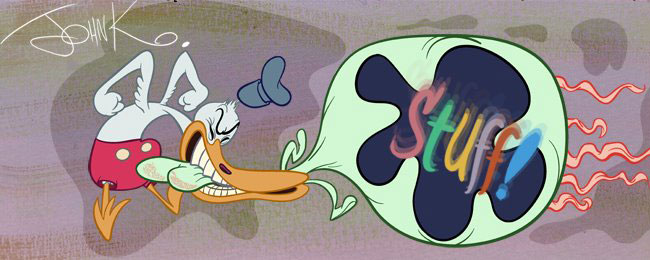

 Here are some layouts by Maurice Noble that illustrate all the concepts I talk about in my BG design posts.
Here are some layouts by Maurice Noble that illustrate all the concepts I talk about in my BG design posts.The layouts are not merely stylish, they are functional and carefully, intelligently planned out and organized.
Distortion-DO NOT DISTORT EVERYTHING, use careful decisions
 These boxes have backwards perspective. We are looking up at them, yet the vertical lines converge downwards. It makes no sense but looks dynamic. Note that all the details on the boxes-the boards and grain follow the same perspective. They don't go every which way. It makes the distortion of the box convincing and easy to read.
These boxes have backwards perspective. We are looking up at them, yet the vertical lines converge downwards. It makes no sense but looks dynamic. Note that all the details on the boxes-the boards and grain follow the same perspective. They don't go every which way. It makes the distortion of the box convincing and easy to read. The rest of the background follows the basic rules. Lots of negative shape around the focus of the scene. Each form is distinct-mountains, ground, plants.
The rest of the background follows the basic rules. Lots of negative shape around the focus of the scene. Each form is distinct-mountains, ground, plants.Details are varied and descriptive - and FOLLOW THE FORMS.
 The main detail is on the cactus. It is an interesting squiggly yet controlled brush pattern that crawls around the form of the cactus. The rest of the BG objects have almost no details, yet each form is stylish, solid and descriptive of what it is: scrub, ground, hills, mountains.
The main detail is on the cactus. It is an interesting squiggly yet controlled brush pattern that crawls around the form of the cactus. The rest of the BG objects have almost no details, yet each form is stylish, solid and descriptive of what it is: scrub, ground, hills, mountains.Noble made a decision: he controlled an urge to cover every object with an equal amount of stylish detail and just chose one main object, so that we could easily see what is happening in the scene.
Look how well planned the scene is Wile E.'s head is perfectly framed in the negative space between the cactus and the mountain.
Divide your picture into few major forms.
 This canyon between two cliffs is very easy to read because they are not tons of objects and details competing for our attention.
This canyon between two cliffs is very easy to read because they are not tons of objects and details competing for our attention.There is a ground plane split by the crevice and one rock formation in the upper corner of the frame, away from the action.
Use Negative space to make your positive major forms read clearly.

Do not completely cover your objects with details, and wrap the details around the form of the objects. And vary the surface physics of your objects so that everything isn't made up of the same substance.
 Note how different the form of the rocks behind Wile E. are from the cliff side behind the rocks. This helps distinguish the two picture planes and makes it easy to see the picture. If the cliff side was rounded and had the same kind of sub forms as the rock, it would blend together like a cluttered wallpaper and we wouldn't see that is hiding behind the rocks.
Note how different the form of the rocks behind Wile E. are from the cliff side behind the rocks. This helps distinguish the two picture planes and makes it easy to see the picture. If the cliff side was rounded and had the same kind of sub forms as the rock, it would blend together like a cluttered wallpaper and we wouldn't see that is hiding behind the rocks.Noble used two different types of rock forms and textures to separate the elements.
The textures do not completely cover the objects either. There is a lot of negative space within the object.
The painter followed up on this concept by using different color families and values for each surface.
ENTER NATE AND THE NEW BREED
Here is a drawing by my latest discovery: Nate
I think he has lots of promise. His BG studies have style and appeal but he could use some tips from the masters (not me but Maurice Noble, Robert Gribbroek and the great layout artists from old cartoons.)
 The houses and tree in this picture have nice solid forms overall. The houses are slightly distorted and the details generally follow the same distortion.
The houses and tree in this picture have nice solid forms overall. The houses are slightly distorted and the details generally follow the same distortion.We could bring out these attributes with some careful adjustments.
1 Use negative space to make the main objects read more clearly.

2 Even organic things made out of lots of little things should have an overall shape.
 Like these Gribbroek layouts:
Like these Gribbroek layouts: The shape of the pine needles are very clear as an overall form, that is then divide into layers of sub forms, on down to the individual needles at the bottom.
The shape of the pine needles are very clear as an overall form, that is then divide into layers of sub forms, on down to the individual needles at the bottom.Squint your eyes and you'll see that they form a wave behind the foreground trees.
3 Divide big areas of a substance into smaller sub forms that fit into the overall pattern.

4 Lastly, add the details - and make them small, so they don't break up the forms.

My attempt at leaves is plum pitiful and that certainly is not the only way to draw foliage, but I am just trying to make the point clearly. Once you have these concepts down, you can vary all your types of forms, substances and textures more artistically.
Just don't try to make a picture by starting with the details. Get an overall graphic statement first that tells the viewer what he's looking at easily, then break it up into careful sub-structures and textures.
A good exercise might be to take some of these muddy looking frame grabs I made from Rabbit Fire and trace them. You can't see a lot of the details, but you can see the major compositions and the second level of forms quite clearly.

 Don't forget to copy the cursor.
Don't forget to copy the cursor.





